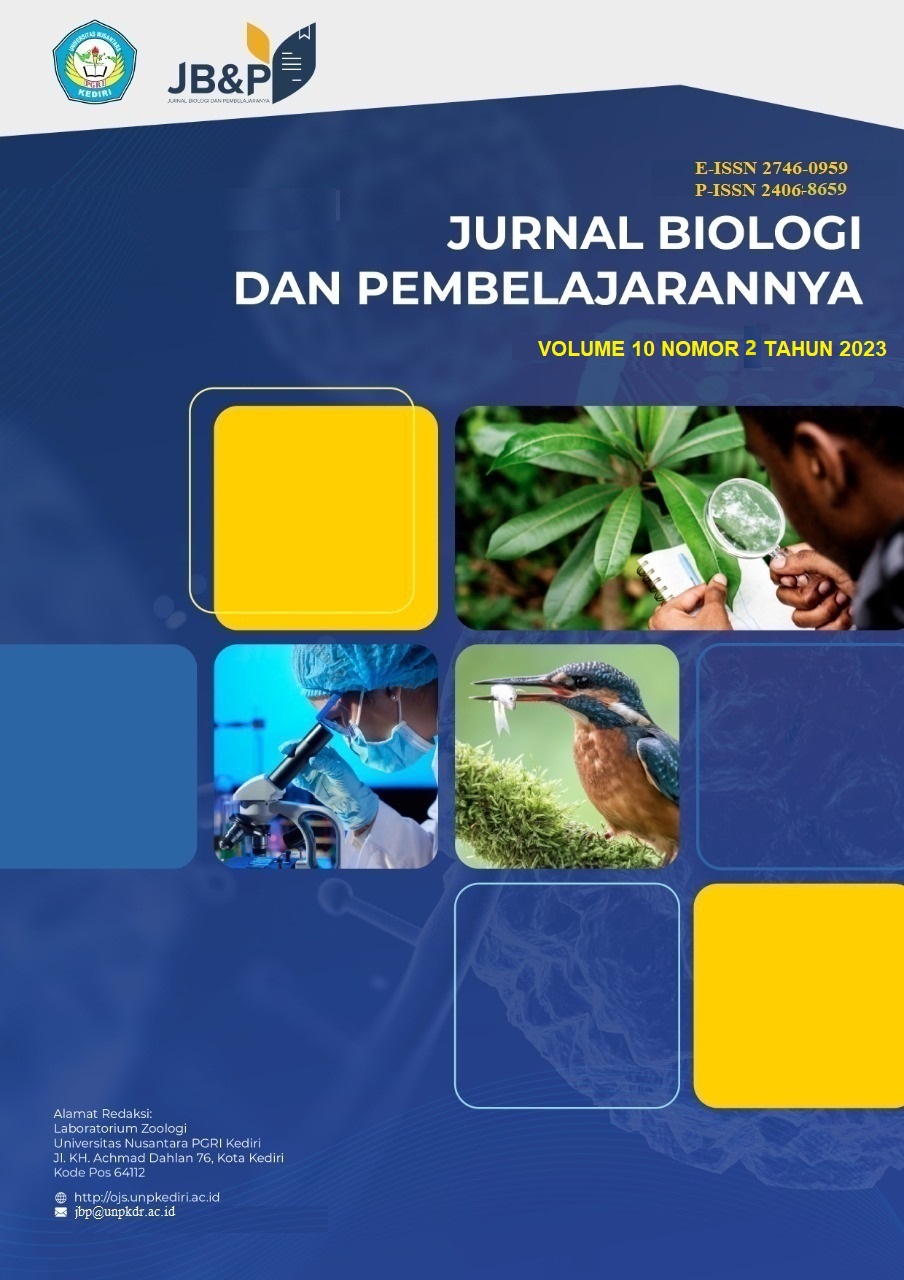Analisis Aspek yang Mempengaruhi Ketertarikan Siswa SMA dalam Pembelajaran Biologi
DOI:
https://doi.org/10.29407/jbp.v10i2.20409Keywords:
biology, interest, learning, studentAbstract
Interest in learning is important in supporting student academic achievement. This often happens in biology subjects in the classroom. Many students expressed boredom in the lesson. Therefore, researchers will dig deeper related to aspects of student's interest in biology learning. The method used is literature study, which analyzes previous research. The results obtained are factors that influence student learning interest in biology subjects depends on student interest in teachers when teaching, interest in biology subjects, feeling happy with the way teachers teach and delivering material, attention to biology subjects, and being involved in the learning process and student tenacity when learning. In addition, internal factors (physical health, drive, arousal, and grasping ability) and external influences (environment, parents, teachers, learning styles, etc.) can affect students' interest in learning, the most important in interest in learning biology in the classroom is the initial and strong intention that students have when learning biology begins in class
References
Chang, C.Y., & Cheng, W.Y. (2008). Science achievement and students’ self-confidence and interest in science: A Taiwanese representative sample study. International Journal of Science Education, 30, 1183–1200. doi: 10.1080/09500690701435384
Cheung, Derek (2017). The key factors affecting students’ individual interest in school science lessons. International Journal of Science Education, 40(1), 1–23. doi: 10.1080/09500693.2017.1362711
Çimer, A. (2012). What makes biology learning difficult and effective: Students’ views. Educational Research and Reviews, 7(3), 61–71. doi: 10.5897/ERR11.205
Dung, N. T., & Fatmawati, D. (2018). General informatics teaching with B-Learning teaching model. Jurnal Pendidikan Biologi Indonesia), 4(1): 85-94. doi: https://doi.org/10.22219/jpbi.v4i1.5312
Farita, Zul. (2019). Analisis Faktor-faktor yang Mempengaruhi Minat Belajar Siswa Pada Mata Pelajaran Biologi Kelas XI IPA SMA Negeri Se-Kecamatan Tenayan Raya Pekanbaru Tahun Ajaran 2018/2019. Skripsi. Fakultas Keguruan dan Ilmu Pendidikan. Riau: Universitas Islam Riau.
Fernandez, V., Tunnisa, L.F., Aulia, N.R., Hidayati, N. (2021). Minat belajar siswa terhadap pembelajaran biologi dengan menggunakan media powerpoint (students' interest in learning biology using powerpoint media). Didaktika Biologi: Jurnal Penelitian Pendidikan Biologi, 5 (1): 17-22. doi: https://doi.org/10.32502/dikbio.v5i1.2993
Francis, L., & Greer, J. (1999). Measuring attitudes towards science among secondary school students: The affective domain. Journal of Research in Science Teaching, 35: 877-896. doi: https://doi.org/10.1080/0263514990170207
Hamzah, Amir. 2019. Metode Penelitian Kepustakaan. Malang: Litersi Nusantara.
Hidi, S. (2006). Interest: A unique motivational variable. Educational Research Review, 1: 69–82. doi: https://doi.org/10.1016/j.edurev.2006.09.001
Hinneh, J. T. (2017). Attitude towards practical work and students’ achievement in biology: A case of a private senior secondary school in Gaborone, Botswana. IOSR Journal of Mathematics, 13(4): 6–11. doi: 10.9790/5728-1304010611
Hong, J.L., Shim, K.C. & Chang, N.K. (1998). A study of Korean middle school students' interests in biology and their implications for biology education. International Journal of Science Education, 20(8): 989-999. doi: 10.1080/0950069980200806
Hulleman, C.S., & Harackiewicz, J.M. (2009). Promoting interest and performance in high school science classes. Science, 326: 1410–1412. doi: 10.1126/science.1177067
Husamah, Fatmawati, D. & Setyawan, D. (2018). OIDDE learning model: Improving higher order thinking skills of biology teacher candidates. International Journal of Instruction, 11(2): 249-264. doi: 10.12973/iji.2018.11217a
Jeronen, E., Palmberg, I., & Tli-Panula, E. (2016). Teaching methods in biology education and sustainability education including outdoor education for promoting sustainability-A literature review. Education Sciences, 7(1): 1–19. doi: 10.3390/educsci7010001
Jones, G., Howe, A., & Rua, M. (2000). Gender differences in students' experiences, interests, and attitudes towards science and scientists. Science Education, 84(2): 180-192. doi: 10.1002/(sici)1098-237x(200003)84:2<180::aid-sce3>3.0.co;2-x
Koballa, Thomas R., Jr. and Crawley, Frank E. (1988). The influence of attitude on science teaching and learning. School Science and Mathematics, 85(3): 222-232. doi: 10.1111/j.1949-8594.1985.tb09615.x
Kubiatko, M., Torkar, G. & Rovnanova, L. (2017). The teacher as one of the factors influencing students’ perception of biology as a school subject. CEPS Journal, 7(2):127–140. doi: 10.26529/cepsj.173
Lestari, D. & Mellisa. (2023). Faktor yang Mempengaruhi Minat Belajar Siswa pada Mata Pelajaran Biologi Kelas Xl MIPA SMA Negeri 4 Pekanbaru Tahun Ajaran 2022/2023 (Factors Affecting Student Interest in Biology Subject Class Xl MIPA SMA Negeri 4 Pekanbaru Academic Year 2022/2023). Jurnal Perspektif Pendidikan dan Keguruan, 14(1): 45-49. doi: https://doi.org/10.25299/perspektif.2023.vol14(1).11238
Lin, H.S., Hong, R.Z. & Huang, T.C. (2012). The Role of Emotional Factors in Building Public Scientific Literacy and Engagement with Science. International Journal of Science Education, 34(1): 25-42. doi: 10.1080/09500693.2010.551430
Menis, J. (1983). Attitudes towards chemistry as compared with those towards mathematics among tenth grade pupils (aged 15) in high level secondary schools in Israel. Research in Science & Technological Education, 1: 185-191. doi: 10.1080/0263514830010206
Noviati, Wiwi. (2020). Kesulitan Pembelajaran Online Mahasiswa Pendidikan Biologi di Tengah Pandemi Covid-19. Jurnal Pendidikan MIPA, 10(1): 7-11. doi: 10.37630/jpm.v10i1.258
Osborne, J., Simon, S. & Collins, S. (2003) Attitudes towards science: a review of the literature and its implications. International Journal of Science Education, 25(9): 1049-1079. doi: 10.1080/0950069032000032199
Taskinen, P.H., Schütte, K., & Prenzel, M. (2013). Adolescents’ motivation to select an academic science-related career: The role of school factors, individual interest, and science self-concept. Educational Research and Evaluation, 19: 717–733. doi: 10.1080/13803611.2013.853620
Trumper, Ricardo. (2006). Factors affecting junior high school students’ interest in biology. Science Education International, 17(1): 31-48.
Prokop, P., Prokop, M. and Tunnicliffe, S.D. (2007). Is biology boring? Student attitudes toward biology. Journal of Biological Education, 42(1): 36–39. doi: 10.1080/00219266.2007.9656105
Sjøberg, L. (1983). Interest, achievement and vocational choice. European Journal of Science Education, 5: 299-307. doi: 10.1080/0140528830050305
Silvia, P.J. (2006). Exploring the psychology of interest. New York: Oxford University Press.
Sugiyono, S. (2011). Metode penelitian kuantitatif, kualitatif dan R&D. Bandung: Alfabeta.
Weinburgh, M. (1995). Gender differences in student attitudes toward science: A meta-analysis of the literature from 1970 to 1991. Journal of Research in Science Teaching, 32: 387-398. doi: 10.1002/tea.3660320407
Yulinda, R. & Ilma, S. (2018). Learning Interest of Biology Pre-Service Teachers on Contextual-Based Plant Morphology Course. Jurnal Pendidikan Biologi Indonesia, 4(2): 171-178. doi: https://doi.org/10.22219/jpbi.v4i2.5881
Downloads
Published
Issue
Section
License
Authors who publish with this journal agree to the following terms:
- Copyright on any article is retained by the author(s).
- The author grants the journal, right of first publication with the work simultaneously licensed under a Creative Commons Attribution License that allows others to share the work with an acknowledgment of the work’s authorship and initial publication in this journal.
- Authors are able to enter into separate, additional contractual arrangements for the non-exclusive distribution of the journal’s published version of the work (e.g., post it to an institutional repository or publish it in a book), with an acknowledgment of its initial publication in this journal.
- Authors are permitted and encouraged to post their work online (e.g., in institutional repositories or on their website) prior to and during the submission process, as it can lead to productive exchanges, as well as earlier and greater citation of published work.
- The article and any associated published material is distributed under the Creative Commons Attribution-ShareAlike 4.0 International License













